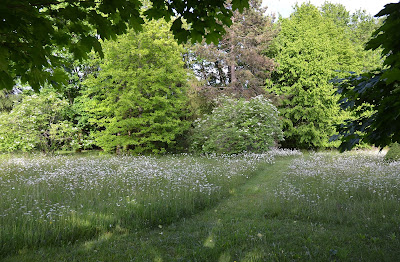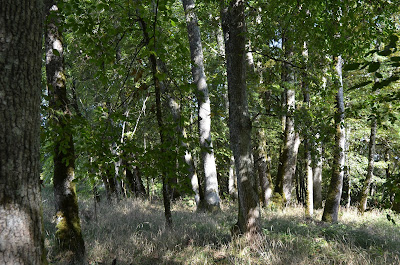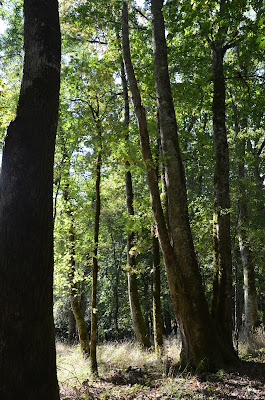The weather vane of our lives changed direction, and we knew it was time to leave. We took off from the snowy mountains and alps and flew west towards the setting sun, with the hope of a new life in a new land. We followed the Rhone as it twisted and squeezed its way through the Jura and across the plains to Lyon, parting company where it turned south to service the flamingo-filled etangs of the Camargue. We climbed up into the barren lands of the central massif, up to its peaks at the extinct volcanoes of the Auvergne. There, waters seeped out of the basalt to form a stream which, like us, struck out westwards. We followed it, the Dordogne, and watched it became strong, cut gorges through hills in its impatience to reach the open seas of the Atlantic, then slow down with the descending massif to embrace the Vézère and as one meander through rolling green hills. Here we also slowed, and below us saw a corner of a new world which we thought we could make home. We descended, and walked into the future.
You're now standing at the east entrance to our new land. Come on in - I'll show you around.
Let's walk on the entrance meadow.
To the right you'll see three old plum trees. I don't know which species or variety they are. Most plums in Europe belong to Prunus domestica, aptly named the European Plum, which has a number of sub-species - our trees fitting more with institia, the damson. But they also have the look of the Cherry Plum (Prunus cerasifera), a native of south-east Europe.On the left, a Judas Tree (Cercis siliquastrum) - a native of southern Europe and western Asia. It belongs to the pea family, and the seeds are like peas in a pod. The myth is that Judas Ascariot hanged himself from this tree, his blood turning the white flowers red - but Judas is more likely a corruption of Judea, where the tree used to be common (and is now protected).Further on the right a large Lilac (Syringa vulgaris), a plant of the olive family that is native to rocky hills in the Balkans. Marianne said she must have a Lilac in the garden - and now she has.
We catch a first glimse of the house as we walk onto the front meadow.Here we are protected by two large trees, a Sycamore and a Cedar.
Continuing left, a Liquidambar - placed so that in autumn its colours out-compete those of the trees behind.From here the garden opens up. A path to the left follows the tree line.
Here we have a Hawthorn with bright red flowers, probably a cultivar of the English Hawthorn (Crataegus laevigata), flanked by two American Cranberrybushes (Viburnum trilobum).We are now in the middle of the front meadow which, like most of the meadows, is blanketed white in Spring by Oxeye Daisies (Leucanthemum vulgare).The house now comes into view.
Continuing on we enter the heart of the front garden - a miscellany of roses and other shrubs.
From here, another path follows the tree line south away from the house and front meadow...
...downhill under Hornbeams (Carpinus betulus)......and into our wood. The wood is one of Downy Oak (Quercus pubescens), a species of southern European limestone soils. Our oaks are old and tall, with twenty or so reckoned to be over 100 years old. They were probably preserved as they were on the land of an old manor house (our neighbours - to whom our house was the métairie, or tenant farmhouse).
In the winter they form a line of skeletal giants.
We can now walk up the west side of the garden. Between us and the front garden is the big hay meadow.
At the end of June this meadow is cut by the local farmer, Stephane, who then teds and bails the hay to be used as winter feed for his cattle.
We've reached the top corner of the meadow, and can gaze east over our walked route.
The path back towards the house is flanked by another old plum tree, and a cherry and apple tree.
The apple tree was particularly fruitful this year.Turning north we walk through the potager meadow, on the west side of the house, so called because I hope that one day it will contain a vegetable garden.
It is flanked to the north by a group of American Oaks and Acers, including a Box Elder (Acer negundo), and miscellaneous shrubs - and towering over them, a mighty Lombardy Poplar (Populus nigra).
They also provide Autumn colour.Around the back of the trees we enter the northern part of the garden which is behind the house, the small hay meadow - also cut and bailed by the farmer in Summer.
Let's walk back through the potager meadow, and make our way to the house. In April, the terrace of the west building, our guest house, is covered with white Wisteria.
After turning the corner we can walk on to the hill meadow, a stonghold of Common Daisies (Bellis perennis) in Spring and yellow daisies in Summer. Looking up at the house and its courtyard, we can imagine the old tenant farm with its farmhouse to the right, animal house to the left, and hay barn in the middle.
At the entrance to the guest house a Mock-Orange, or False Jasmine, (Philadelphus species) provides May blossom and scents the courtyard.
Sheltering the walls, Mophead and Lacecap Hydrangeas reach their peak in July.The farmouse building is clad in Roses and Honeysuckle in Summer, and rich red Virginia Creeper in Autumn.The central old barn building is fringed with a vine of red grapes.
To bring life and colour at scale to the expanse of gravel in the courtyard, I have planted large pots.
Despite all my efforts, I couldn't outshine my favourite perennial.
Now we sit and stare at the front lawn, where a magnificent Poplar commands our view whilst sheltering a ragged Tulip Tree. Often, when in the house, we hear a downpour of rain - but walking outside it is dry, and there is just the sound of the Aspen quaking in the wind. Under the tree we think of what wildlife we might share this land with.During the day we hear shots in the surrounding woods, a sign of large beasts (apart from the hunters) roaming around us - but with sunset a calm descends and, being far from light pollution, we are plunged into darkness.
Around our fire of fallen branches we listen to Roe Deers bark, Red Deers roar, and the fluty hoots of Tawny Owls. Filled with a mixture of excitement, trepidation and Pécharmant, and under the gaze of the great hunter Orion, we silently wonder what tomorrow, and all our future tomorrows, will bring.

































































Beautiful! Such a lot of land with such interesting trees and plants! Amelia
ReplyDeleteEmotive description of journey and discovery.
ReplyDeleteWhat a beautiful place with such diversity of plants and animals.
The garden must be a satisfying challenge to maintain and evolve.
We would love to visit........
You will visit!
DeleteFabulous calendar of the seasons, when each bit is at its best. A tree with its own space develops to its natural shape: the feature which distinguishes the "Parc" from the forest.
ReplyDeleteIndeed. The forest is a struggle for survival, the 'parc' a place for pampered divas.
Delete